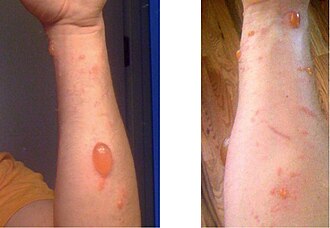Allergic contact dermatitis
Contact allergic dermatitis is a manifestation of type IV hypersensitivity to substances that come into direct contact with the skin (usually haptens).
Etiology and pathogenesis[edit | edit source]
The development of contact allergic eczema takes place in two phases: sensitizing and accessory. Due to their size, haptens acquire antigenic properties only after binding to epidermal protein carriers. The antigen is detected and processed by Langerhans cells, which present it to T-lymphocytes. Langerhans cells then migrate to the regional lymph nodes where they change their phenotype. They secrete IL-1, IL-6 and TNF-α, resulting in the proliferation of T-cell clones that have receptors for the specific antigen. T-lymphocytes then migrate to various organs, including the skin (10-20%). The sensitization process spreads throughout the body, with at least 5-7 days required for complete sensitization. The onset of sensitisation is influenced by a number of factors such as the duration and intensity of the action of the allergen, its allergenic properties, the state of immunity and the disposition of the individual. The resulting hypersensitivity is usually permanent.
- Common sensitising agents:
- metals (Ni, Co - jewellery, watches);
- cosmetics ingredients;
- work environment chemicals;
- local anaesthetics;
- dyes etc.
After leaving the vessels, the T-lymphocytes can be activated by contact with the appropriate antigen. Macrophages, mast cells and possibly keratinocytes are used as accessory phase. Each new contact between the allergen and the sensitized T-lymphocytes triggers the immediate release of cytokines that direct the immune response to remove the allergen from the body as quickly as possible.
If contact eczema is caused by a single substance, it is called monovalent hypersensitivity, more than 1 and less than 5 substances cause oligovalent hypersensitivity, with more causing agents being polyvalent hypersensitivity. Group hypersensitivity refers to a specific part of the primary antigen molecule, resulting in hypersensitivity to a number of chemicals that contain this structure in their molecule. Combined hypersensitivity is caused by the simultaneous or following action of two allergens in one substance.
Clinical picture[edit | edit source]

The manifestations appear 24-48 h after contact with the causative agent and are limited to the location of contact only. In the acute phase, highly reddened edematous deposits are formed with rapidly eroding papulovezicles. Oozing on the surface can occur. Rarely we can see the formation of bumps. Microscopically spongiosis and intracellular oedema are visible resulting in intraepidermal vesicles. Later crusts form. In the chronic phase, the surface becomes hyperkeratotic and forms ragads or lichenification dominate.
The hematogenous form is caused by a substance to which the patient is sensitized by the bloodstream to the skin, where it causes urticaria. Chronic contact eczema may also spread haematogenously or lymphogenically beyond the primary site of contact.
Diagnostics[edit | edit source]
In addition to a careful medical history, the basic examination is an epicutaneous test. The principle is the application the test substance under standard conditions and in the correct concentration to healthy skin at a time interval of 2-3 weeks after the skin manifestations are healed. The following is an evaluation and interpretation
More detailed information can be found on the Epicutaneous test page .
Differential diagnosis[edit | edit source]
It is necessary to distinguish:
In chronic manifestations we distinguish
Therapy[edit | edit source]
The basic precondition is to remove the antigen and prevent it from continuing to cause problems. In the acute phase, we apply drying dressing, later solutions of organic dyes, creams, ointments. Using local corticosteroids are effective, in chronic forms of eczema, they are combined with ichthammol or tar preparations. For resistant types, X-ray irradiation with a Bucky lamp can be sometimes effective.
Links[edit | edit source]
Related articles[edit | edit source]
References[edit | edit source]
- ŠTORK, Jiří. Dermatovenerology. 1. edition. Galén, Karolinum, 2008. ISBN 978-80-7262-371-6.
- KLENER, P. Internal clinic. 3. edition. Galén, 2006. ISBN 80-7262-430-X.

